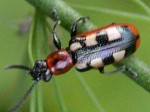 Brought to North America from Europe, the common asparagus beetle was first observed in the United States on Long Island in the mid 1800s. It spread rapidly and by the early 1900s was found in California. Now it can be found any place that asparagus is grown, including wild asparagus, if moisture is sufficient. Problems tend to be greater in cooler climates so the southern states and California have less problems than elsewhere. Common asparagus beetle feeds only on asparagus. Both larvae and beetles feed on the shoots and leaves, the adults beginning first as soon as the asparagus plants appear in the spring. The larvae deliver double damage by staining the plants with a black secretion. A related species, the spotted asparagus beetle, also damages asparagus but is considered less of a problem.
Brought to North America from Europe, the common asparagus beetle was first observed in the United States on Long Island in the mid 1800s. It spread rapidly and by the early 1900s was found in California. Now it can be found any place that asparagus is grown, including wild asparagus, if moisture is sufficient. Problems tend to be greater in cooler climates so the southern states and California have less problems than elsewhere. Common asparagus beetle feeds only on asparagus. Both larvae and beetles feed on the shoots and leaves, the adults beginning first as soon as the asparagus plants appear in the spring. The larvae deliver double damage by staining the plants with a black secretion. A related species, the spotted asparagus beetle, also damages asparagus but is considered less of a problem.
 Description: The adults are about ¼ inch long, bluish black with six cream colored spots on its back. The eggs are bullet shaped and blue-black, the larvae are plump, wrinkled and slug-like. The life cycle takes about 3-4 weeks beginning in spring so can repeat itself many times during a growing season. A few days after emerging from the soil and feeding the adult females lay eggs that hatch in 3 to 8 days. The larvae feed for 10 to 14 days and then enter the soil where they spin cocoons and pupate for 5 to 10 days, when they emerge to start the cycle again. In winter, adults hide in garden debris.
Description: The adults are about ¼ inch long, bluish black with six cream colored spots on its back. The eggs are bullet shaped and blue-black, the larvae are plump, wrinkled and slug-like. The life cycle takes about 3-4 weeks beginning in spring so can repeat itself many times during a growing season. A few days after emerging from the soil and feeding the adult females lay eggs that hatch in 3 to 8 days. The larvae feed for 10 to 14 days and then enter the soil where they spin cocoons and pupate for 5 to 10 days, when they emerge to start the cycle again. In winter, adults hide in garden debris.
 Control: Control efforts are directed at all phases of the life cycle. Beetles, larvae and eggs can be picked off plants and dumped in soapy water. The adult beetles are small and fast, and most active in the afternoon so morning is the best time to pick. Birds feed on the beetles especially before the foliage becomes dense, so encouraging them into the area can help limit beetle numbers. Larvae can be knocked off plants to the soil with a broom; they are usually not able to regain their position on a plant before roasting in the sun. Cleaning up garden debris in late fall removes overwintering adults. Many beneficial insects such as ladybird beetles, soldier bugs, flies, dragon flies, and wasps feed on or parasitize the various stages of the life cycle. Of these, the one that is most likely to give substantial control is the metallic green wasp, Tetractichus asparagi, that parasitizes the asparagus beetle eggs. There are insecticides that can be useful in severe cases but they are likely to kill beneficial insects, including honey bees, so should be used as a last resort.
Control: Control efforts are directed at all phases of the life cycle. Beetles, larvae and eggs can be picked off plants and dumped in soapy water. The adult beetles are small and fast, and most active in the afternoon so morning is the best time to pick. Birds feed on the beetles especially before the foliage becomes dense, so encouraging them into the area can help limit beetle numbers. Larvae can be knocked off plants to the soil with a broom; they are usually not able to regain their position on a plant before roasting in the sun. Cleaning up garden debris in late fall removes overwintering adults. Many beneficial insects such as ladybird beetles, soldier bugs, flies, dragon flies, and wasps feed on or parasitize the various stages of the life cycle. Of these, the one that is most likely to give substantial control is the metallic green wasp, Tetractichus asparagi, that parasitizes the asparagus beetle eggs. There are insecticides that can be useful in severe cases but they are likely to kill beneficial insects, including honey bees, so should be used as a last resort.
Photo from Wikipedia
